Ever gazed upon a basswood piece and wondered, “Can I stain this beauty?” Dive in, and let’s unravel this woodworking enigma together!
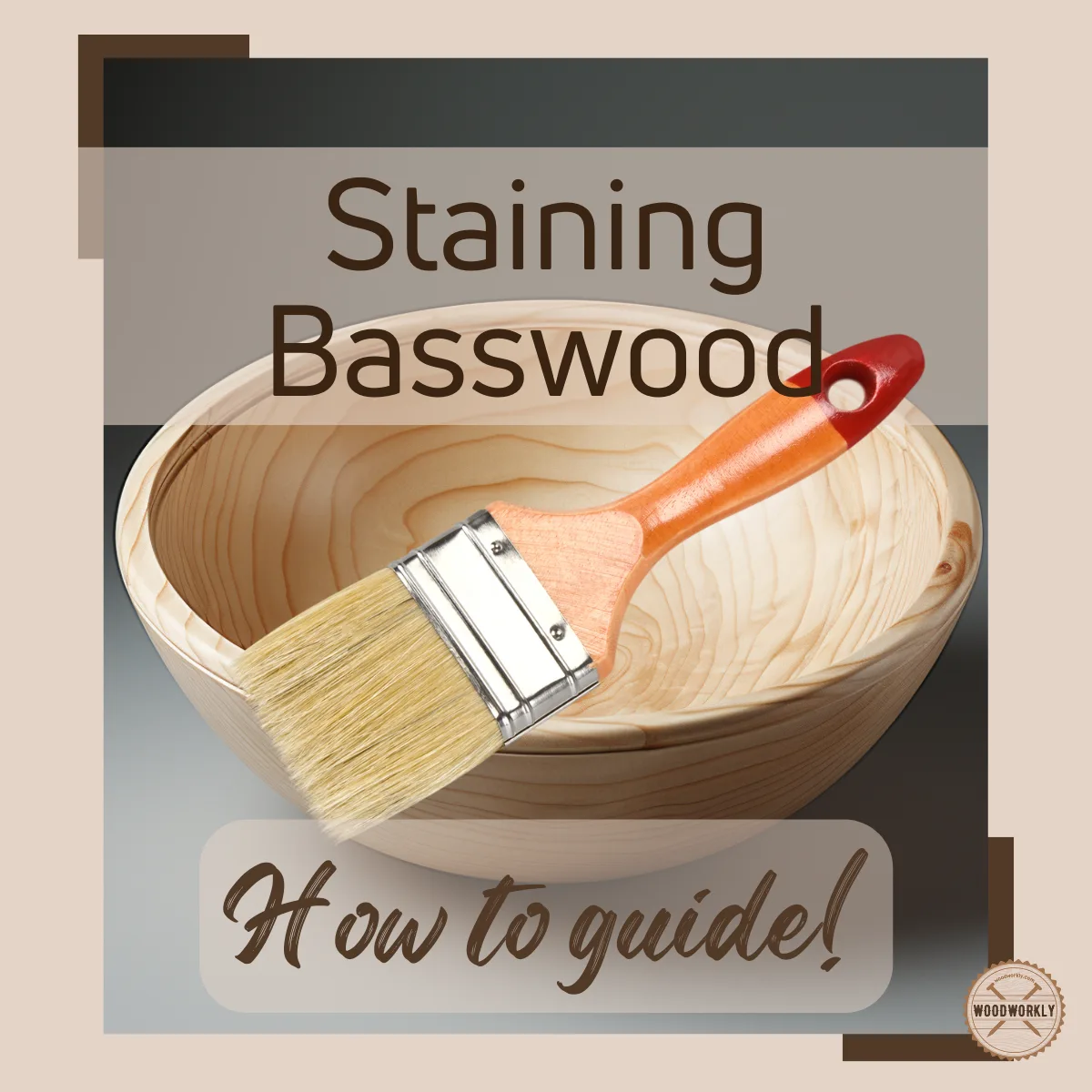
Basswood is a popular soft hardwood that mostly uses for wood carving projects, furniture, and musical instrument making.
When I was working with basswood, I was curious about the staining properties of basswood to get the desired look and protection I wished.
So, I did some research with the help of experts to know the staining and finishing properties of Basswood.
Here’s what I’ve learned about, Can you stain Basswood?
Yes, you can stain basswood. Basswood’s light color and porous nature make it ideal for staining, resulting in a vibrant and even finish. Always use particle stain on basswood for the best results and seal with a topcoat to enhance its longevity and appearance.
But there’s not all there to know about!

So, in this article, I’ll deeply explore can you stain basswood, does basswood stains easily, the best stain for basswood and how to stain basswood using proper methods, and many more.
Furthermore, I’ll answer some frequently asked questions as well.
Let’s jump in!

Does Basswood Stain Easily?
Staining basswood is difficult especially if you apply stain on bare wood since basswood is super soft and absorbs stain too much.
You cannot make a stain to sit on the basswood surface since the wood is so thirsty and soak up the stain like a sponge.
But with pre-stain wood conditioner, staining basswood has become so much easy since it will slow down the absorption rate of the wood.
Apply wood conditioner before stain and it helps to absorb stain more evenly throughout the wood by minimizing wood staining mistakes like blotches and streaks.
Basswood has a diffuse pores-tight grain structure that absorbs stains unevenly. Uneven stain coatings may cause a lot of issues like providing poor protection and it doesn’t enhance the wood’s appearance.
Plus, gaining the color you want same as all over the wood is also difficult.
Therefore, if you’re willing to stain basswood carving, woodwork, or furniture, better to apply wood conditioner first and then go for the staining process.
Otherwise, you’ll have to use too much stain to make stain coating on top of the surface and it is a waste of time and money.
Basswood needs to be sealed and conditioned before staining. Otherwise, it can be a nightmare to get a uniform stain layer.
With proper staining, you can give it any color you want with good protection from environmental elements such as moisture, insect attacks, UV light, and much more.
Stain helps to protect basswood furniture from environmental impacts while enhancing the wood’s appearance.
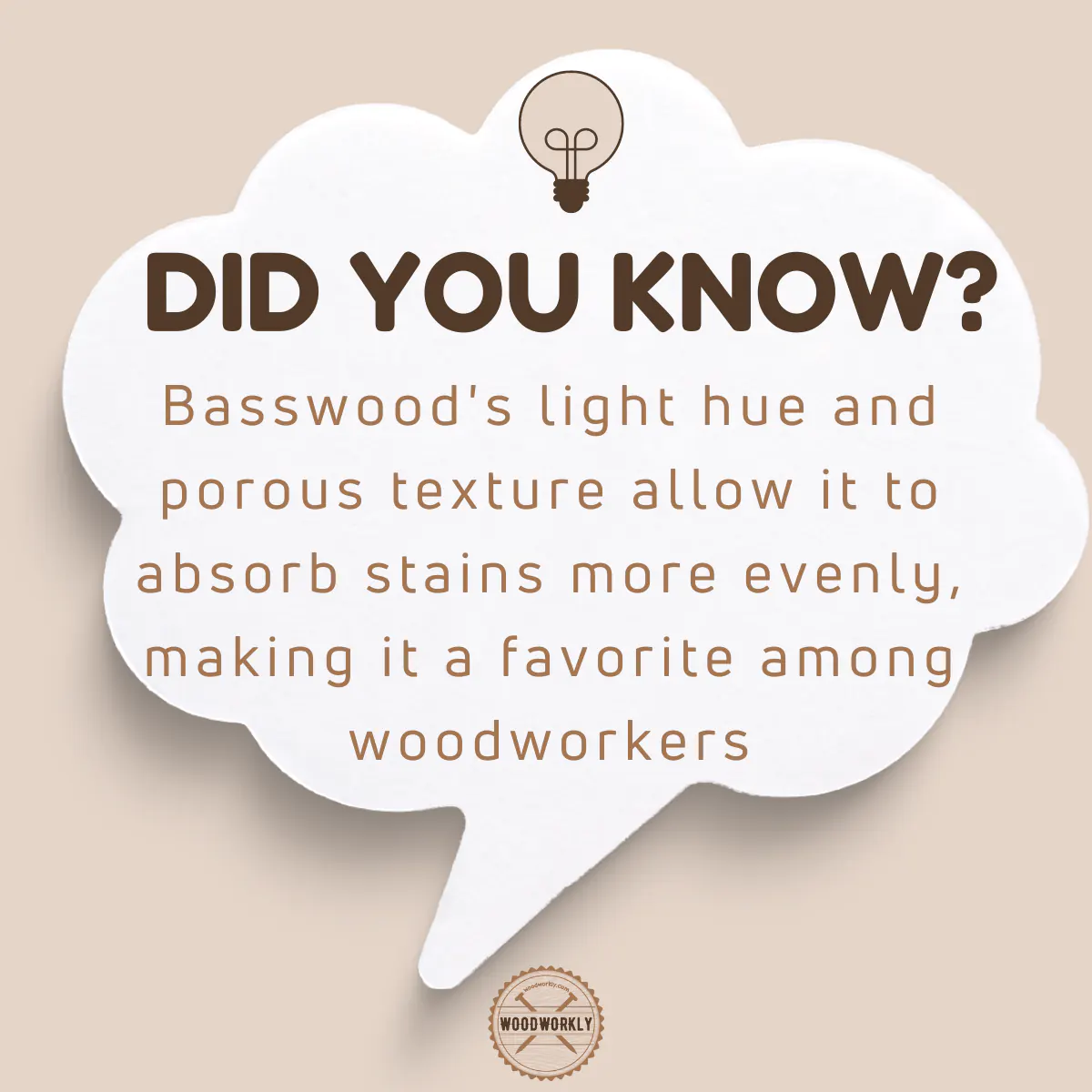
Best Stain Colors for Basswood
When it comes to staining wood, basswood stands out as a fantastic choice.
Its light color, fine grain, and porous nature allow it to readily accept stains, resulting in rich and vibrant hues.
But with so many stain colors available in the market, how do you pick the best ones for basswood?
Let’s dive into the heart of the matter.
The Natural Appeal
Basswood’s light hue is its canvas. If you’re going for a rustic or minimalist aesthetic, a clear or natural stain can be perfect.
This preserves basswood’s inherent beauty, just giving it a subtle enhancement.
Think of that log cabin’s homely charm or the Scandi-cool vibe; sometimes, less is indeed more.
Example: Imagine a hand-carved basswood bowl sitting on a farmhouse table, its clear stain echoing the wood’s authentic texture and complementing the surrounding décor.
Warm Tones: Embrace the Coziness
If you desire a warmer, cozier atmosphere, opt for stains in the golden or honey range.
These tones enhance the warmth of basswood, creating a homey feel.
Perfect for living room furniture or bedroom pieces where the aura of snug comfort is paramount.
Personal Anecdote: I once had a basswood coffee table stained in a rich honey tone.
Every time I sat around it, the table seemed to exude warmth, making coffee sessions all the more intimate.
Darker Shades: Elegance and Sophistication
For those looking to achieve a more luxurious and sophisticated vibe, darker stains like mahogany, walnut, or even ebony can work wonders.
They transform the humble basswood into a piece that looks regal and expensive.
Example: Picture a grand basswood bookshelf in your study, stained in deep mahogany. It not only holds your precious books but also commands attention with its majestic hue.
Playful Vibes with Colored Stains
Who says wood stains need to be conventional? For the more adventurous, there are colored stains, from blues to greens and even reds.
Basswood’s porous nature means it absorbs these well, letting you create unique, standout pieces.
Perfect for artistic projects or when you want to add a splash of color to your space.
Personal Experience: A friend of mine once crafted a basswood clock and stained it in a vibrant teal. It became the room’s focal point, a conversation starter, and a testament to thinking outside the box.
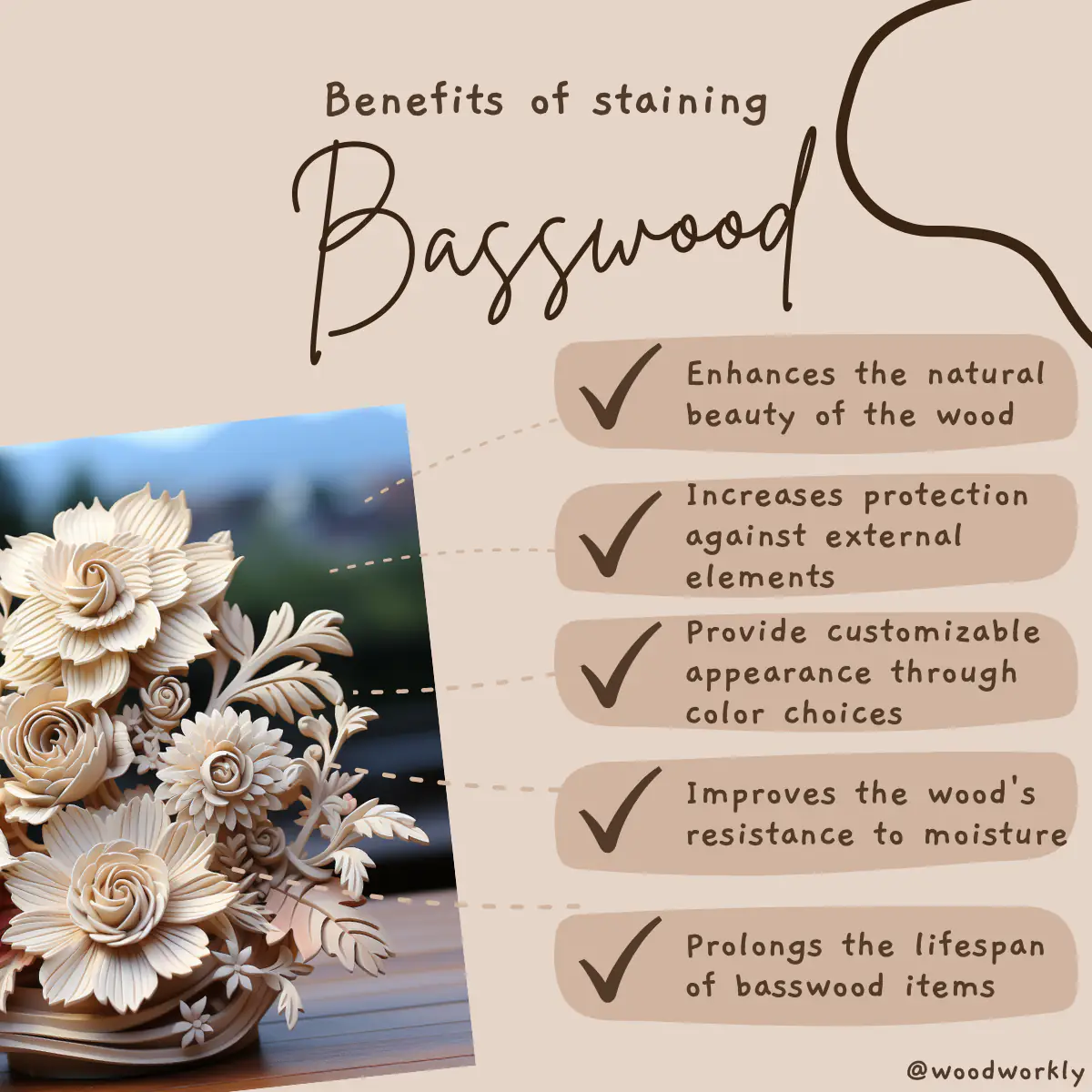
Best stain For Basswood
Because of being difficult to stain, you need to be wise when selecting stain products for basswood.
Here’re some popular stain products for basswood,
- General Finishes Oil-Based Gel Stain
- Minwax Penetrating Wood Stain
- Ready Seal Exterior Stain and Sealer
- Rust-Oleum Varathane Premium Wood Stain
- SamaN Water-Based Wood Stain
Among the above different types of stain products, Gel stain is the best stain for basswood since it sits on a wooden surface rather than absorbing into the wood like regular stains.
In summary, here’re the different applications of the above wood stains.
| Wood Stain Product | Applications |
| General Finishes Oil-Based Gel Stain | Best stain for Basswood |
| Minwax Penetrating Wood Stain | Basswood outdoors projects |
| Ready Seal Exterior Stain and Sealer | Best basswood penetrating stain |
| Rust-Oleum Varathane Premium Wood Stain | Best stain for basswood floors |
| SamaN Water-Based Wood Stain | Best stain for basswood furniture |
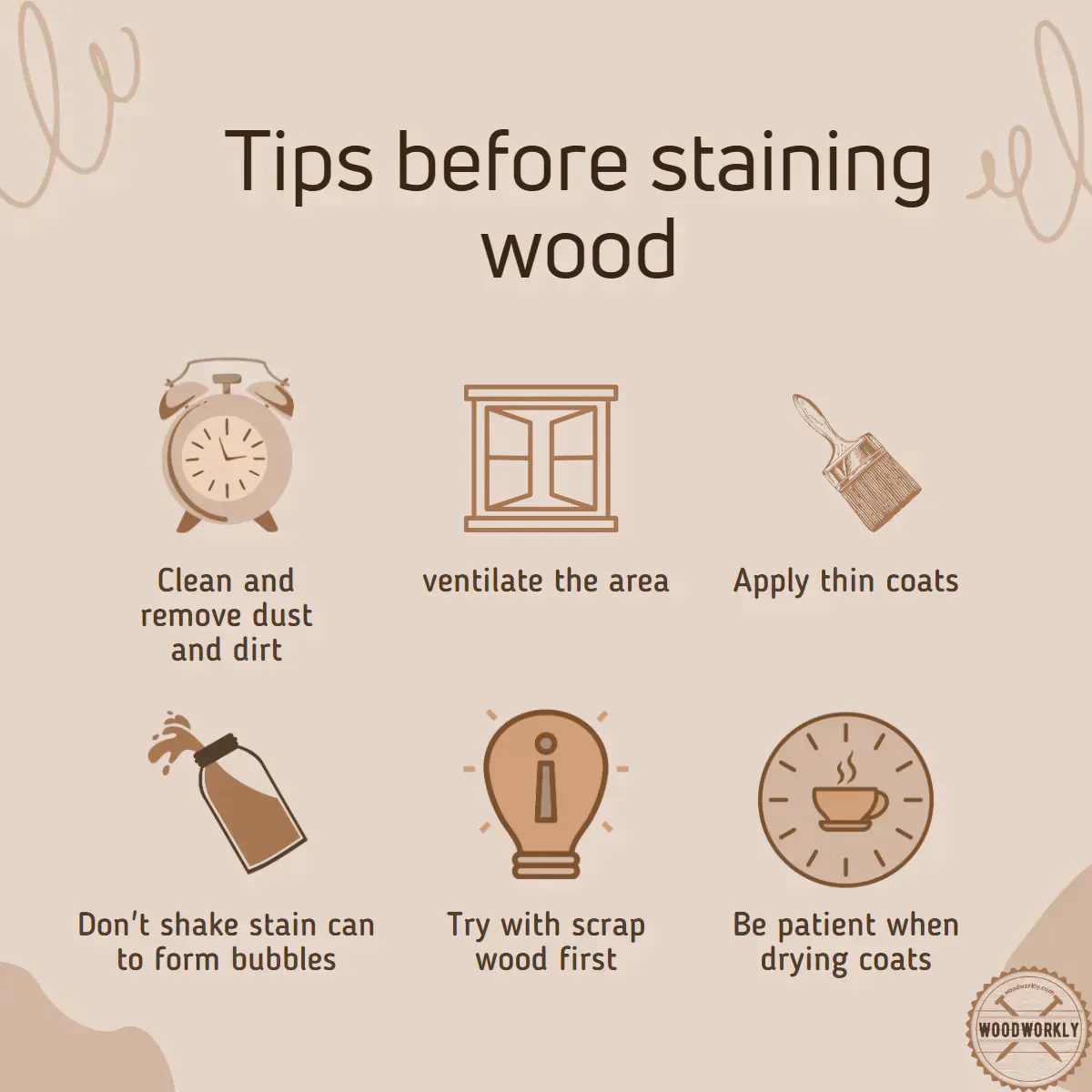
So, let’s discuss each of the above stain products and see how they work with basswood.
General Finishes Oil-Based Gel Stain on Basswood
Because of being a gel stain, General Finishes Oil-Based gel stain is the best product for basswood.
Gel stain sits on basswood without penetrating inside like regular stains. This helps stain to spread evenly throughout the basswood without any blotches.
Here’re the main qualities of General Finishes Oil-Based gel stain,
- Gives an attractive finish to the basswood surface.
- Heavily bodied and doesn’t penetrate too deep into the wood.
- Need less amount of stain than a regular stain on basswood.
- Easy to apply and wipe off.
- Provides an even appearance.
General Finishes Oil-Based gel stain is able used for both indoor and outdoor furniture, woodwork, and wood carving projects of basswood.
It protects wood from environmental elements like moisture, UV light, and insect attacks while enhancing its appearance.
General Finishes Oil-Based gel stain gives too dark color to basswood.
But you can give any color you want for basswood because it has various color options like American Oak, Walnut, Grey, Black, Mahogany, etc.
Here’re some specifications of General Finishes Oil-Based gel stain.
| Color | American Oak, Walnut, Grey, Black, Mahogany, and more |
| Drying Time | 24 hours between coats |
| Type | Satin Oil-Based |
| Applications | Wood carvings, Furniture |
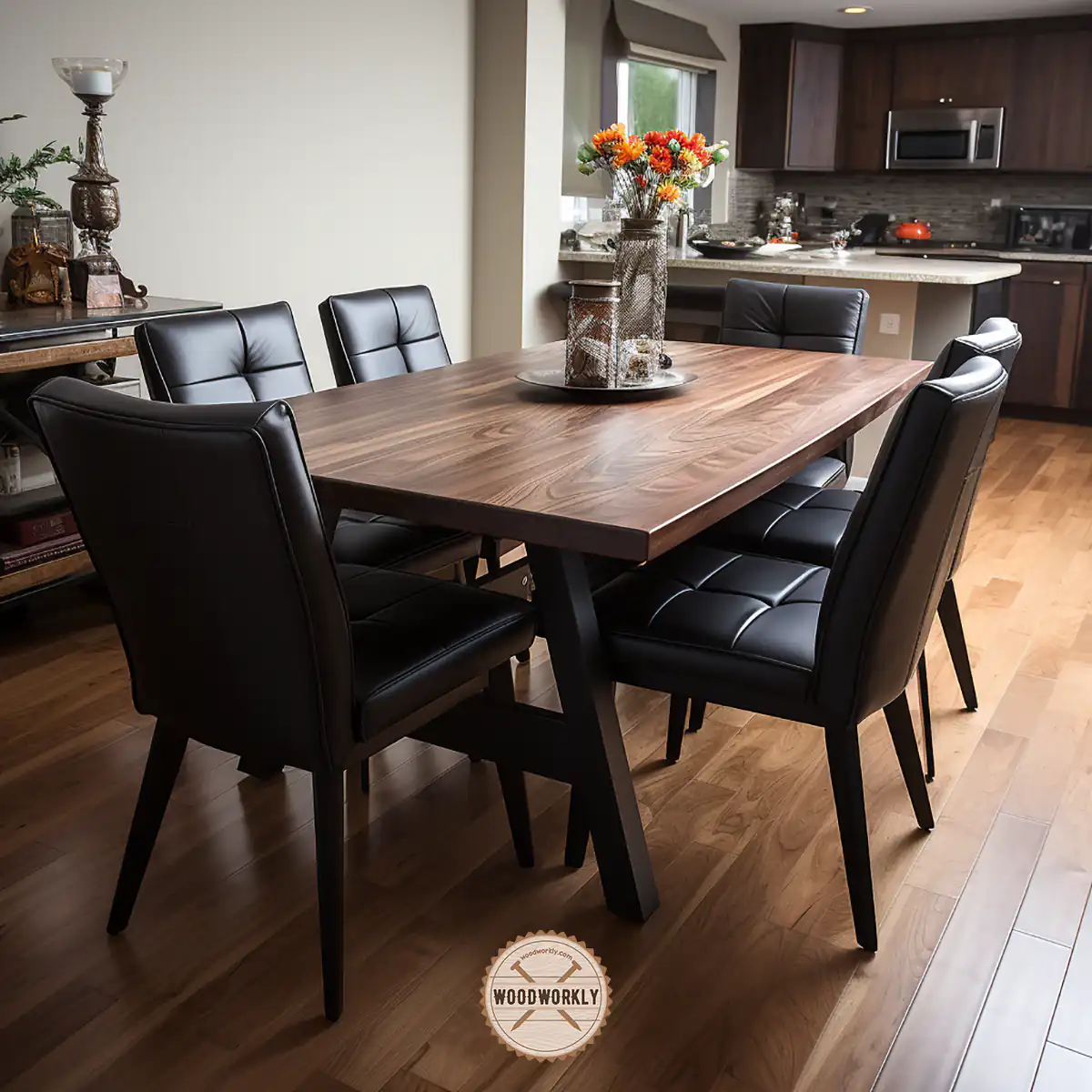
Minwax Penetrating Wood Stain on Basswood
Minwax is a popular wood finisher manufacturer for any wood. Minwax Penetrating Wood Stain is a deep penetrating wood stain that works really well with basswood.
It enhances the natural beauty of basswood while giving so many color options.
Minwax Penetrating Wood Stain protects basswood furniture, wood carvings, and other woodwork by penetrating too deep into wood fibers.
It improves the durability of basswood projects.
Here’re some qualities of Minwax Penetrating Wood Stain,
- Penetrate too deep into the wood to highlight the wood grain
- Easy to apply
- Available in 28 different colors
- Increase the durability of basswood
Apply Minwax Penetrating Wood Stain along the direction of the basswood wood grain for better penetration and to spread evenly.
With a pre-stain wood conditioner, Minwax Penetrating Wood Stain prevents wood from getting a blotchy surface.
Here’re some specifications of Minwax Penetrating Wood Stain.
| Color | 28 different colors |
| Drying Time | 2 Hours |
| Type | Oil-Based stain and sealer |
| Applications | Wood carvings, Furniture, Trims, Doors |
Ready Seal Exterior Stain and Sealer on Basswood
Ready Seal Exterior Stain and Sealer is an excellent wood stain for basswood.
It penetrates well into the wood and makes a protective coating over the wooden surface with an enhanced wood appearance.
Ready Seal Exterior Stain and Sealer has special chemical ingredients to protect the wood from environmental impacts.
Therefore, Ready Seal Exterior Stain and Sealer is great for outdoor basswood projects as well.
Here’re the main qualities of Ready Seal Exterior Stain and Sealer,
- No primer is required
- Provide UV protection
- Easy to apply
- Waterproof the wood
- No back brushing is needed
- Thermal resistance
- Take up to 14 days to reach its actual color
Here’re some specifications of Ready Seal Exterior Stain and Sealer.
| Color | Darker and Golden colors |
| Drying Time | 24 Hours |
| Type | Oil-Based stain and sealer |
| Applications | Outdoor Furniture and wood carvings |
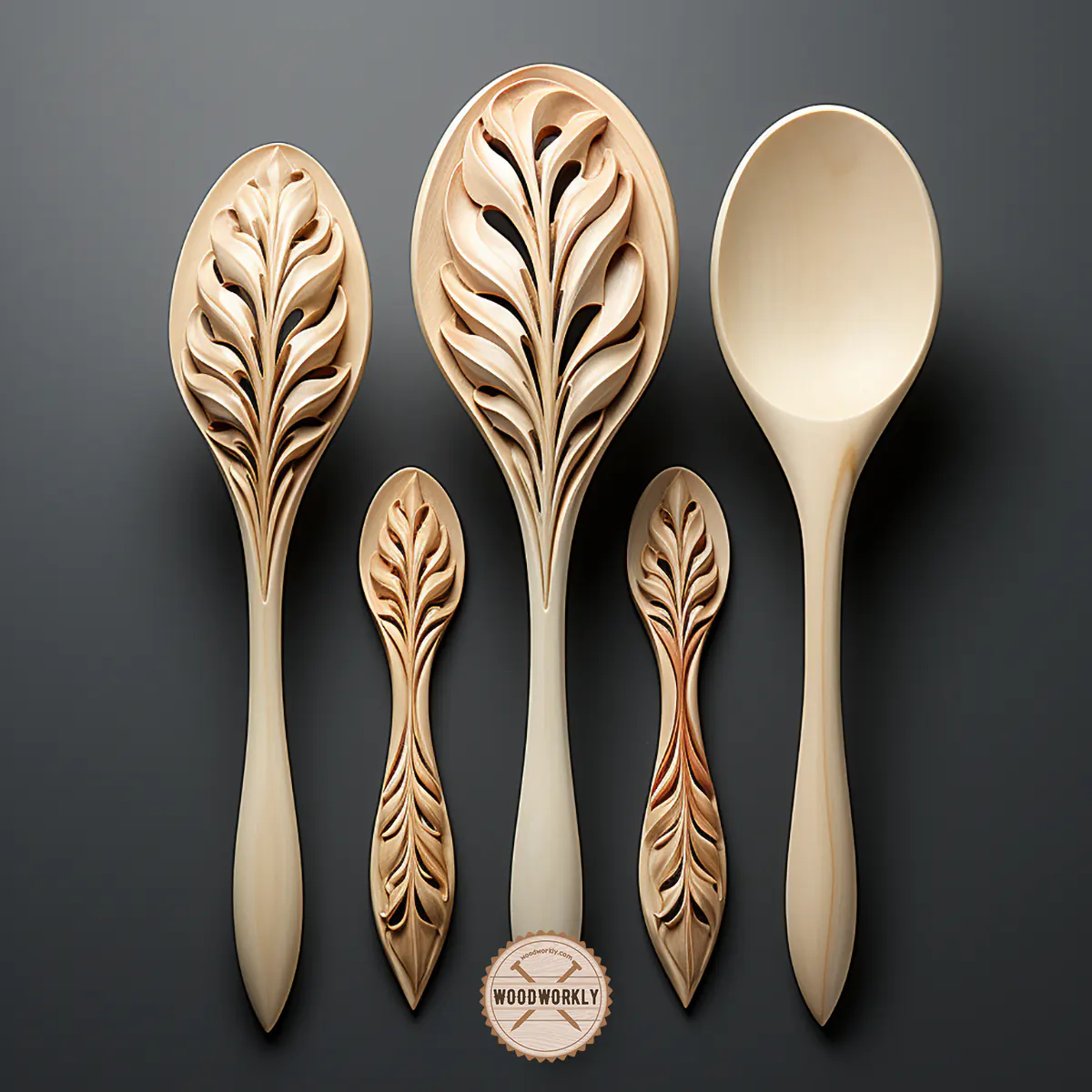
Rust-Oleum Varathane Premium Wood Stain on Basswood
Rust-Oleum Varathane Premium Wood Stain is excellent for basswood floors since it can tolerate foot traffic.
Use Rust-Oleum Varathane Premium Wood Stain applied basswood on low-traffic areas like study rooms, and bedroom floors.
Rust-Oleum Varathane Premium Wood Stain is able to give protection while enhancing the basswood color for any kind of basswood application.
It has rich translucent pigments that help to give the wood any color you want.
Here’re some qualities of Rust-Oleum Varathane Premium Wood Stain,
- Dries fast
- Easy to apply
- Give rich appearance to the wood
- Easy to wipe and able to get evenly spread stained surface
Here’re some specifications of Rust-Oleum Varathane Premium Wood Stain.
| Color | Semi-Transparent |
| Drying Time | 2 hours between coats |
| Type | Oil Based stain |
| Applications | Basswood floors and Indoor furniture |
SamaN Water-Based Wood Stain on Basswood
SamaN Water-Based Wood Stain is the best water-based stain product for basswood furniture and wood carvings.
It is odorless and doesn’t yellow like oil-based stains.
SamaN Water-Based Wood Stain is eco-friendly and non-toxic. Therefore, it can be used for kitchen furniture and children’s toys made with basswood.
Here’re some main qualities of SamaN Water-Based Wood Stain,
- Water-based stain
- Easy to apply
- Odorless
- Available in 40 different colors
SamaN Water-Based Wood Stain is able to apply to any basswood project. it enhances the wood color while giving excellent protection against moisture.
Here’re some specifications of SamaN Water-Based Wood Stain.
| Color | Walnut and 40 different colors |
| Drying Time | 2 hours between coats |
| Type | Water-Based stain |
| Applications | Basswood wood carvings and furniture |
Now you have a clear idea about the best stain products that can use on basswood with no issues.
But you need to have a clear understanding of the method that you’re going to stain basswood since the wood is not stain-friendly so much like Aspen or Cedar.
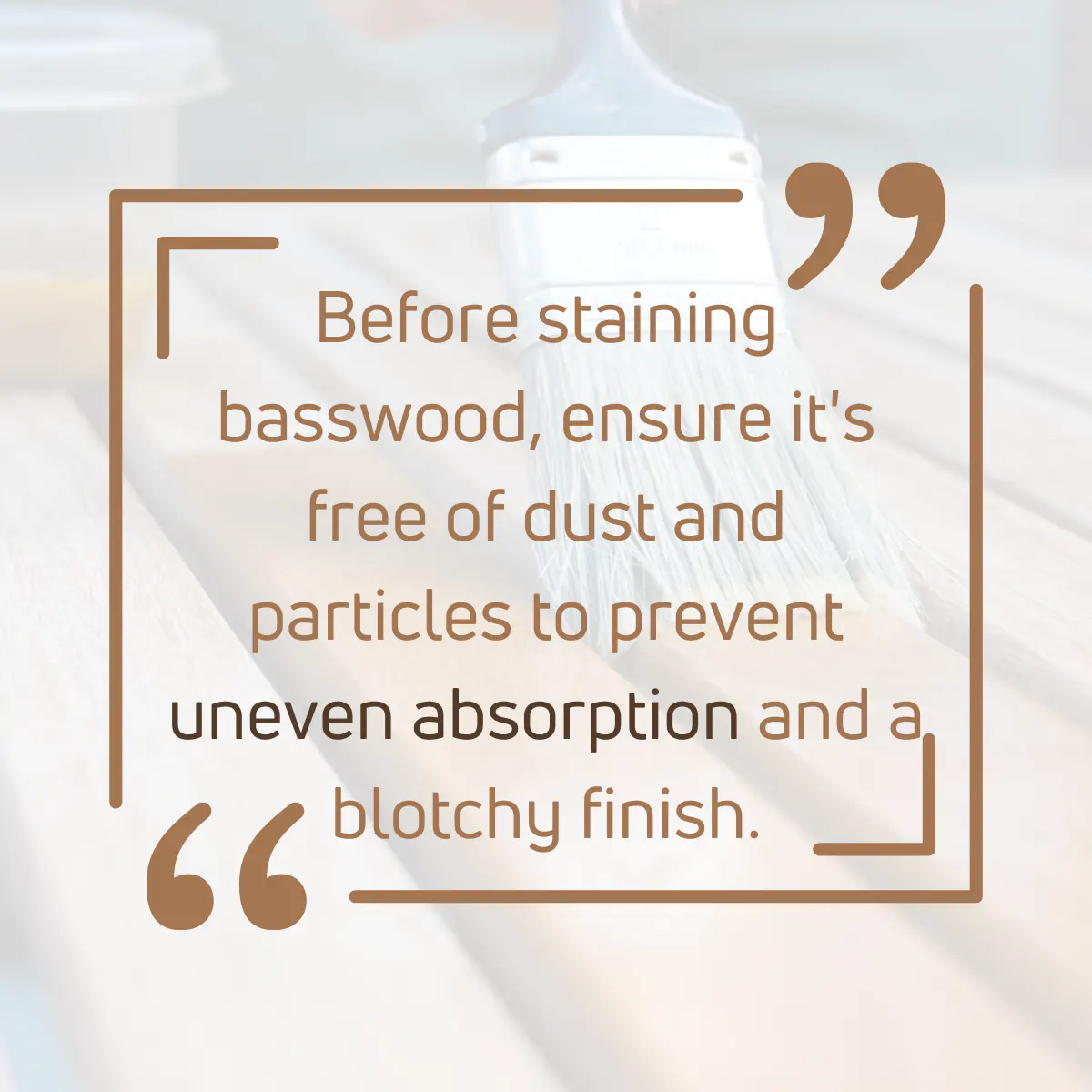
Does Basswood Need Wood Conditioner Before Staining?
Yes, basswood needs a wood conditioner before staining to slow down the stain penetration rate of the wood and spread out the stain evenly throughout the surface.
Basswood is difficult to stain because it soaks up stain like a sponge. Therefore, you need lots of stains to apply on basswood if you directly apply stains on bare wood.
In order to prevent the stain from wasting better to apply wood conditioner first and then go for the staining process.
Wood conditioner penetrates into the wood fibers and limits their absorption rate. Once the wood conditioner settled in on the surface, the wood fibers will no longer absorb stains too deep.
You’ll be able to apply the stain evenly and make them sit on the surface with only a little amount than before.
Pre-stain wood conditioner helps to minimize wood stain mistakes like blotches and streaks because it helps to get a uniform stain coating.
Make sure to wait at least 15 minutes after applying the wood conditioner before staining since it needs some time to settle in.
Wipe the excess wood conditioner on the surface to make the staining process much easier.
Apply pre-stain wood conditioner and stain product from the same manufacturer to avoid incompatibility issues.
I use Minwax pre-stain wood conditioner and Minwax stain on basswood because they match perfectly with no trouble.

First, you need to gather the items for the staining job.
Supplies You Will Need for Staining Basswood
- 220 grit sandpaper
- Pre-stain wood conditioner
- Wood stain product
- Gloves
- Clean rags
- Paintbrush
- Latex gloves
Check out the Best Brushes For Staining Wood!
Grab the above supplies from a quality manufacturer and get ready to stain basswood.
How To Stain Basswood?
Staining basswood on bare wood is difficult since wood absorbs too much stain before making them sit on the surface.
So, let’s talk about how to stain basswood with the help of a wood conditioner for a good outcome.
Here’re the steps you need to follow when staining basswood,
- Clean and prepare the wood surface
- Sand and remove sawdust
- Apply wood conditioner
- Let the wood dry
- Apply wood stain
- Let the wood dry and cure completely
- Seal the stained wood
So, let’s discuss each of the above staining steps to share our knowledge in basswood staining.
Tip: Before staining the main basswood project better to test the stain with basswood scrap wood to see how it goes.
This way you can select the color that suits most for your basswood furniture or woodwork.
1. Clean and Prepare Wood Surface
Cleaning is one of the most essential steps in wood staining. Take rags and eliminate dust, dirt, and grease on the basswood surface.
If you start the staining when the dust is there, you’ll probably end up with a blotchy surface since dust blocks the stains from settling on the wood.
If cleaning with rags or cloths is difficult, you can use soapy water to remove dust and dirt so well.
But make sure to let the surface dry well before moving on to the next step.
2. Sand and Remove Sawdust
After cleaning the wood properly, sand the entire surface with 220 grit sandpaper to eliminate surface randomness and make the surface smooth before staining.
Sand along the direction of the basswood grain to avoid wood from scratching. Sanding helps to open pores structures of basswood to make them ready to absorb stain so well.
Do the sanding with even pressure to get a super smooth nice surface.
Now your surface is super ready to take on the stain.
3. Apply Wood Conditioner
Applying a wood conditioner is a must when staining basswood since it absorbs stain like a sponge and makes an uneven surface.
Wood conditioner helps to slow down the absorption rate of basswood and spread-out stain evenly all over the wood.
Apply wood conditioner along the direction of the basswood grain without missing any spot.
Test the conditioned basswood surface by wetting it to notice uneven areas and apply the wood conditioner again to make the surface uniform.
Because uneven areas turn too dark once the stain is applied.
4. Dry The Wood Completely
After applying the wood conditioner let it dry on wood for about 1 -2 hours.
Don’t apply wood stain right after applying wood conditioner because that may result in a blotchy or tacky surface.
Usually, wood conditioners settle on basswood within 15 minutes but you have to wait until it is completely dry to move on to the next step.
5. Apply Wood Stain
After proper conditioning, apply wood stain on basswood by dipping paintbrush so little in the stain can.
Apply stain along the direction of the wood grain for better absorption and to spread evenly without forming blotches.
Generally, basswood turns dark once the stain is applied. But you can change its color by applying a thin coat of stain with the color you prefer.
Because of the previously applied wood conditioner, basswood won’t suck up stain like a sponge.
It absorbs stain so little and lets the stain sit on the surface by making a protective coating.
This protective coating helps basswood to protect from moisture, insect attacks, UV light, and much more while improving its beautiful appearance.
Apply 2 -3 coats of stain on basswood to get a good outcome with the color you want.
Better not to go over 3 coats because stain coats won’t dry quicker, and you might be ended up with a tacky surface which can be so hard to remove.
6. Let The Wood Dry Completely
Make sure to let the wood dry for at least 24 hours between each stain coat. never apply stain on a wet surface because that may ruin the wood’s appearance.
After applying the final coat of stain, let the wood dry for 24 hours and let it cure for around 3 – 4 days until it reaches its actual color.
7. Seal the Stained Wood
Once the stain is set (typically after 24 hours), apply a transparent coat to shield and preserve the basswood.
You can opt for polyurethane, lacquer, or a transparent wood finish. Use a top-notch brush for application, and always bear in mind – applying in slender layers is key!
Now you know how to stain basswood properly without making any mistakes.
This strategy is straightforward and suitable for woodworkers of all skill levels to achieve the most refined look on Basswood.
Next, I’ll offer some advice that has consistently worked for me during my basswood staining endeavors.
The following pointers are gleaned from my extensive experience in finishing various Basswood furnishings.
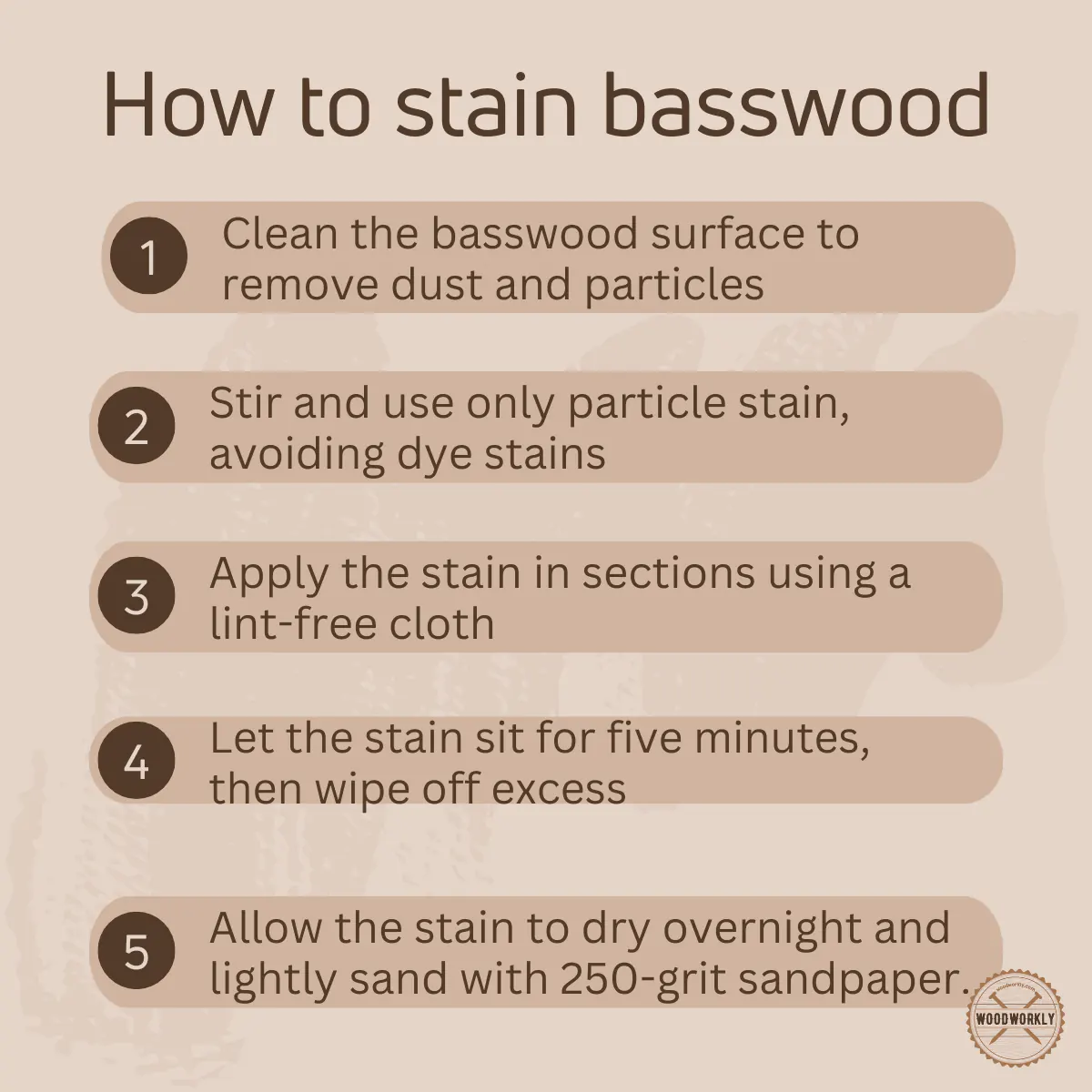
Tips for Staining Basswood
Staining basswood can be a transformative experience for both the wood and the artisan.
It brings out the rich tones, textures, and character of the wood. But to get it just right, you need to follow some key steps.
Grab a coffee, pull up a chair, and let’s dive into the world of staining basswood together!
1. Preparation is Key
Before you even open that can of stain, ensure your basswood is clean and free of any dust or debris.
Wiping it down with a lint-free cloth will help create the ideal surface for staining.
Side note: Just the other day, I rushed into staining without cleaning the wood properly, and let’s just say the results were…well, less than ideal.
2. Stir, Don’t Shake
When you’re ready to begin, open your stain and give it a good stir using a stirrer.
Stirring helps combine any particles that may have settled at the bottom. Shaking might introduce bubbles, which can affect the final finish.
3. Choose the Right Stain
As mentioned in the articles, it’s recommended to use a particle stain on basswood rather than a dye stain.
This type of stain will highlight the wood’s natural grains and ensure an even application.
4. Application Matters
Using a lint-free cloth, apply the stain in even back and forth strokes. Remember: Don’t rush this step.
Consider it therapeutic! If you’re working on a large piece, tackle it section by section instead of staining the entire surface at once.
5. Mind the Time
After applying, allow the stain to soak in for about five minutes. The longer you let it sit, the deeper the color will be.
But don’t let it dry out; wipe away any excess stain to ensure a uniform color.
Did you know? I once got sidetracked and forgot about the stain soaking. My piece ended up much darker than expected.
A happy accident, but a reminder to keep an eye on the clock!
6. Smooth It Out
Once your stain dries (usually best to leave it overnight), give it a light sanding with a fine-grit sandpaper.
This step helps in smoothing out any raised grain resulting from the staining process.
7. Seal the Deal
Finally, apply a topcoat, either water or solvent-based, to seal in the stain and give your basswood that lovely finished look.
This protective layer also helps increase the wood’s durability and ensures the stain remains vibrant for longer.
8. Safety First
Stains can be potent, and it’s always a good idea to work in a well-ventilated area.
Don a pair of gloves and perhaps even a mask to avoid inhaling any fumes.
Quick story: A friend of mine once decided to stain indoors without much ventilation. The headache that ensued was a lesson learned the hard way!
9. Experiment a Little
Before committing to staining the entire piece, test the stain on a small, inconspicuous section.
Different batches of basswood might react differently to the same stain, so it’s always good to have a sneak peek of the final look.
10. Enjoy the Process!
Remember, woodworking, including staining, is as much about the journey as the result. Embrace each step, learn from any mistakes, and take pride in bringing out the best in your basswood.
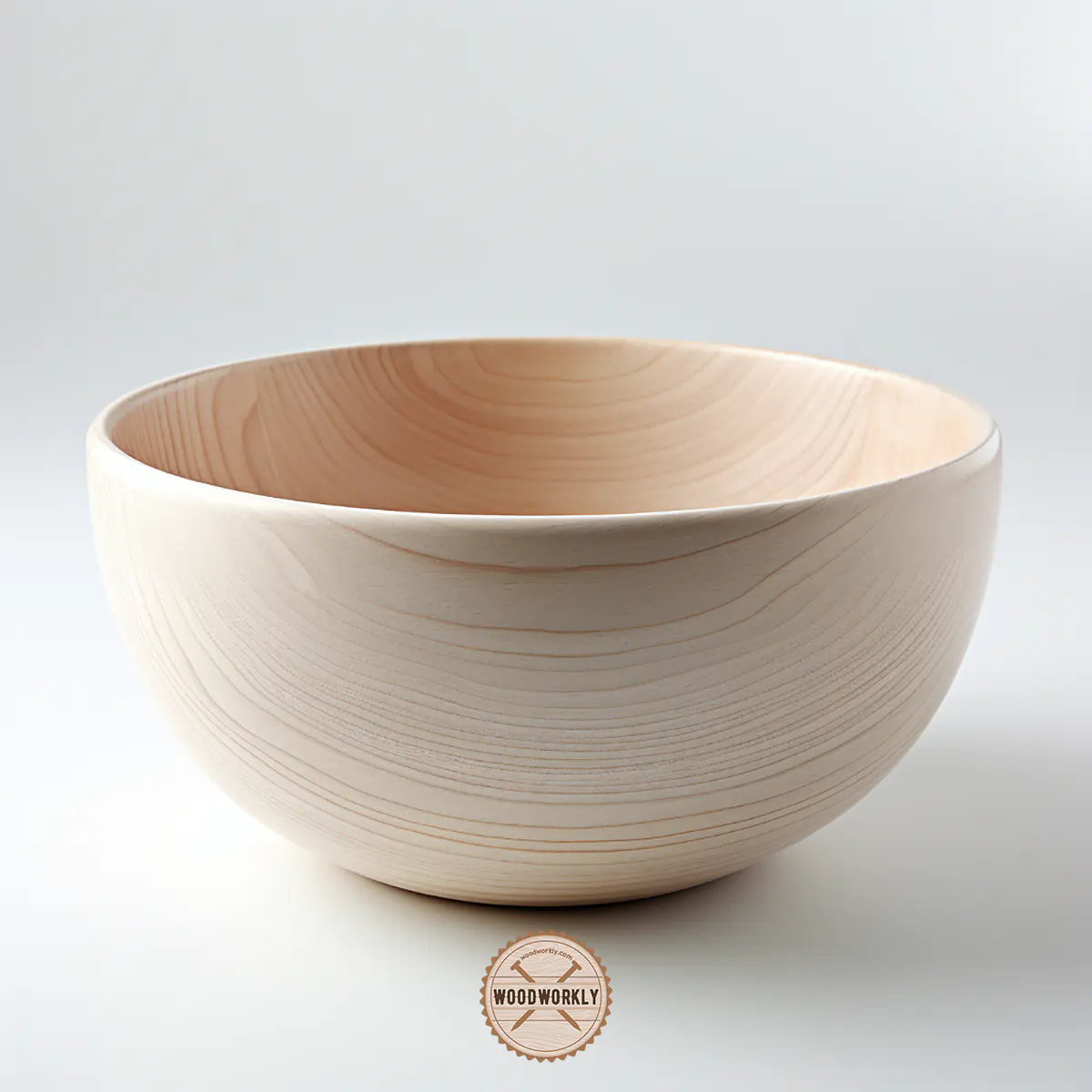
Does Basswood Stain Like Pine?
Both pine and basswood are difficult to stain.
Even though pine wood is a softwood and basswood is a hardwood, both are extremely soft, and they absorb a stain like sponges. Plus, they stain unevenly on bare wood.
Apply wood conditioner before staining to stain both basswood and pine easily with an evenly spread surface.
Staining pinewood is almost the same as staining basswood because of its almost equal qualities.
Does Basswood Stain Like Cedar?
Cedar stains so much better than basswood since it accepts stains so well with or without wood conditioner .
Stain spread evenly through cedar wood surfaces and helps to make a protective coating that protects cedar wood furniture and woodwork from UV rays, moisture, and mildew.
Applying stain on cedar is much easier than basswood since accepts stain so well and you improve its natural beauty with opaque, semi-opaque, semi-transparent, clear, or natural options.
Does Basswood Stain Like Teak?
Teak is easier to stain than basswood; however, staining teak is unnecessary because it naturally produces its own oil that protects the wood from environmental elements and enhances its appearance.
Therefore, most woodworks do not put much effort when staining teak wood. It repels bugs and insects and protects wood by itself.
This is why teak has become so popular in furniture making industry over other woods.
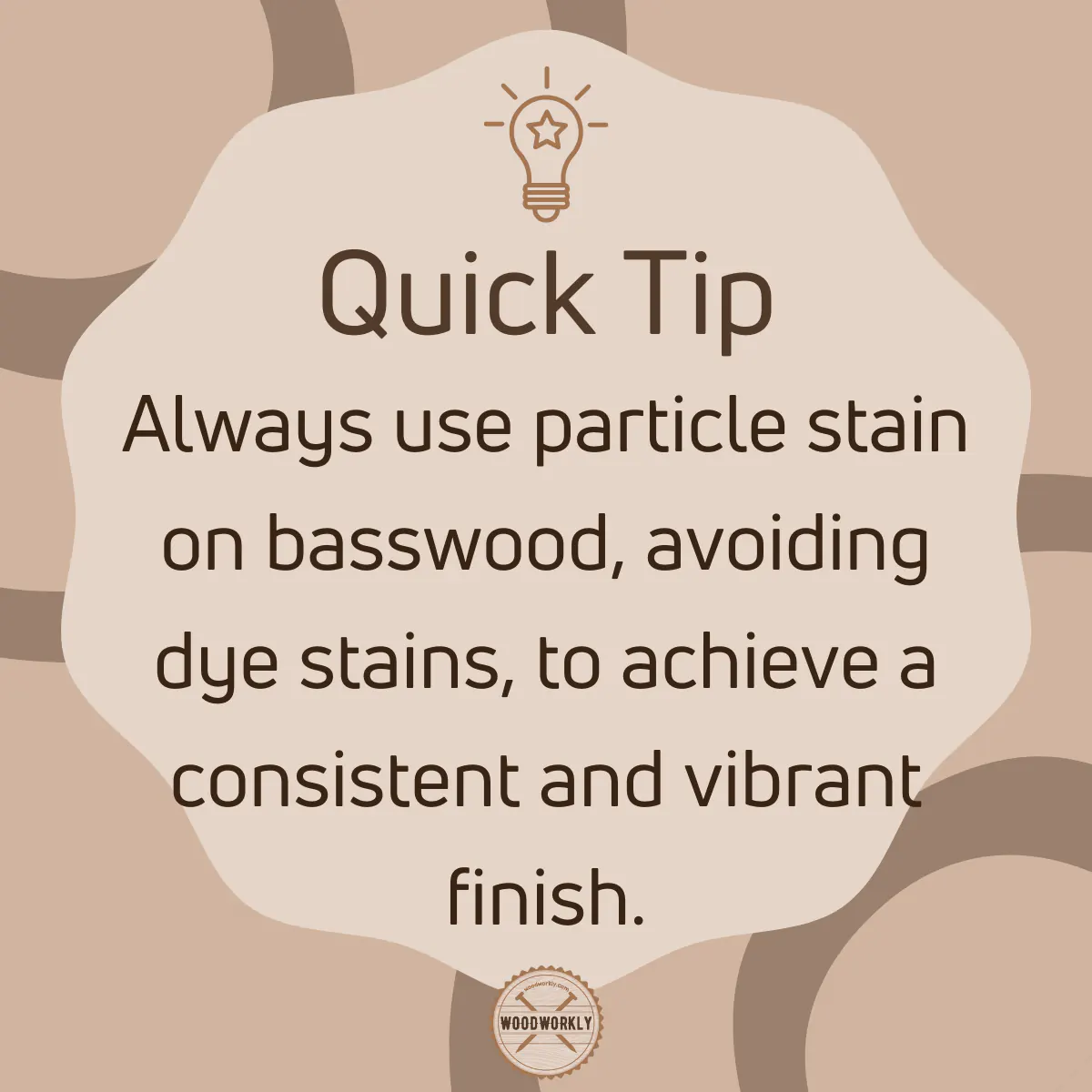
Maintenance And Care Tips for Stained Basswood Furniture
Stained basswood furniture can be a stunning addition to any home, capturing attention with its rich hues and polished appearance.
However, like all treasures, it requires care to keep its shine intact.
With that in mind, let’s delve into some essential tips to keep your stained basswood pieces looking their best.
1. Regular Dusting: The First Line of Defense
It might sound basic, but regular dusting goes a long way. Dust and pollutants can act as abrasives on the surface of your furniture.
Using a soft, lint-free cloth, give your furniture a gentle wipe down at least once a week.
Friendly Tip: Don’t forget those nooks and crannies! A soft paintbrush can be perfect for reaching tight corners.
2. Mind the Spills
Accidents happen. But when they do, it’s vital to act quickly. If there’s a spill, blot it promptly with a clean cloth.
Avoid rubbing it in, as that might spread the stain or cause damage to the wood’s finish.
Little Anecdote: I once spilled red wine on my basswood dining table. Immediate blotting and a touch of mild soapy water saved the day (and my table)!
3. Avoid Direct Sunlight
Prolonged exposure to direct sunlight can cause the stain on basswood to fade.
If your furniture is near a window, consider using curtains or blinds to shield it from those harsh UV rays.
Personal Thought: It’s like sunscreen for your furniture. Protect it from those sunny days to maintain its youthful glow.
4. Humidity Matters
Basswood, like most woods, can warp or crack with drastic changes in humidity.
If you live in an area with seasonal changes, consider using a humidity monitor.
This way, you can ensure the environment is just right for your furniture.
5. Be Wary of Hot or Wet Objects
Hot mugs or damp vases can leave unsightly marks on your basswood furniture.
Always use coasters or mats to protect the stained surface.
Friendly Reminder: Those coasters in the drawer? They aren’t just decorative items. They’re armor for your furniture. Use them!
6. Regularly Check for Defects
Over time, even with the best care, furniture might show signs of wear. Periodically inspect your basswood pieces for any minor scratches or defects.
If you spot any, a touch-up with a matching stain or a protective finish can keep the piece looking fresh.
7. Deep Cleaning and Polishing
Every once in a while, your furniture might benefit from a deeper clean.
Use a mild wood cleaner to give it a thorough wipe, followed by a polish to bring out its shine.
Remember, always test any cleaner or polish on a small, inconspicuous area first.
Fun Fact: Did you know? Polishing not only adds shine but also provides a thin protective layer against dust and scratches!
8. Rotate and Rearrange
If you have basswood pieces in high-traffic areas, consider rotating or rearranging them periodically.
This ensures even wear and tear, keeping your furniture looking balanced and uniform.
Congrats folks! Now you know can you stain basswood and how to stain basswood perfectly using proper techniques with all the tips.
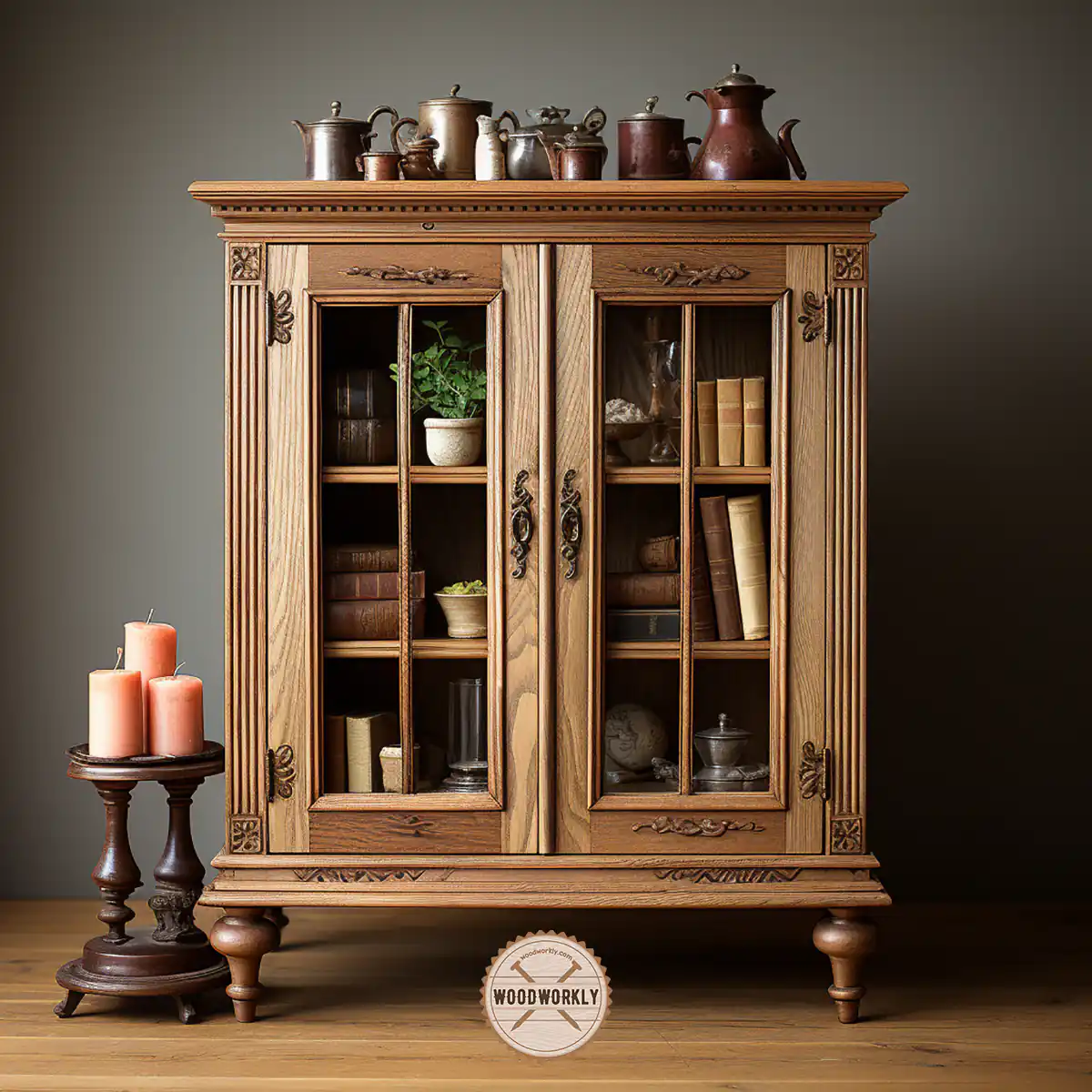
So, let’s answer some frequently asked questions.
FAQs
Do I need to use a base coat before staining basswood?
No, basswood has minimal sap and dips, so you can skip the base coat and dive straight into the staining process, which simplifies the whole endeavor.
What kind of stain should I use on basswood?
Particle stain is recommended for basswood. Avoid dye stains as they might not give the desired finish on this type of wood.
How long should I let the stain sit on basswood before wiping it off?
Generally, you’d want to let the stain sit for about five minutes before wiping off any excess. This duration ensures an optimal color intensity and finish.
Do I need a topcoat after staining basswood?
Yes, a topcoat, either water or solvent-based, is suggested to seal the stain, enhance its longevity, and provide a polished look to your basswood piece.
Can I use a paintbrush to stain basswood?
Certainly! While many recommend using a spray gun for easier application, especially in carved pieces, a soft nylon-bristled brush can also do the trick, reaching hidden parts of the carving and giving a smooth finish.
What’s the benefit of staining basswood for wood carving projects?
Staining not only enhances the natural beauty of basswood but also adds artistic value, making carvings and furniture pieces more aesthetically pleasing and potentially increasing their market value.
Did I cover all you wanted to know about: Can You Stain Basswood?
In this article, I’ve deeply discussed about can you stain basswood and how to do that by taking the best stain products for basswood and how it interacts with stain to get protected from environmental elements.
Yes, you can stain basswood pretty well by applying pre-stain wood conditioner before staining. Basswood is a soft hardwood that soaks up stain like a sponge and wood conditioner helps to slow down the stain absorption rate of basswood and helps to absorb stain evenly. It gets too dark after staining.
The stain makes basswood darker and helps to protect and color wood carvings and furniture.
Furthermore, I’ve answered some frequently asked questions as well.
Hope you have gained good knowledge about can you stain basswood without messing things up.
Try to stain the scarp basswood piece as your next wood finishing project and see how it goes with the above-discussed method.
Keep practicing to be the pro at wood staining!